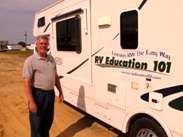When I was in the military I was in charge of some very large fleet maintenance operations. As a maintenance officer a term that was near and dear to me was preventive maintenance. Preventive maintenance is maintenance you perform on your vehicle before a problem exists. These checks are designed to prevent or identify potential problems that could lead to mechanical breakdown, malfunction or failure of a component or system. Preventive maintenance consists of cleaning, inspecting, lubricating, adjusting and servicing your vehicle. In the military there were preventive maintenance checks that the vehicle operator was responsible for and preventive maintenance checks that different echelons of maintenance personnel performed.
Since my days in the military I continue to perform preventive maintenance on my automobiles and the RV. For the most part I would classify these checks as operator level preventive maintenance checks, that almost anyone is capable of performing. Don’t confuse this with scheduled maintenance. Scheduled or routine maintenance is performed in intervals normally based on time, mileage or hours. Scheduled maintenance is designed to keep your vehicles in top operating condition and prevent untimely breakdowns and repairs.
Note: It is absolutely essential that you read your owner’s manual and warranty information in regards to who is responsible for what when it comes to scheduled maintenance. Scheduled maintenance that is required by the manufacturer and not performed can void your warranty.
With the hot weather upon us I thought it appropriate to list some simple preventive maintenance checks you can make on your automobile or RV before heading out on a trip.
Chassis Hot Weather Preventive Maintenance:
Check your owner’s manual for routine and scheduled maintenance intervals. Have all scheduled maintenance performed as recommended.
Check all fluid levels: engine oil, transmission, power steering, brakes, windshield washer. Top off according to owner’s manual guidelines.
Check the air filter: A dirty air filter can lower fuel economy by 10%, replace as required.
Check for any leaks: Inspect the engine compartment and underside of the RV for any signs of leaks. Leaks of any type can lead to costly repairs and untimely breakdowns. Catching a leak early can save time and money. Identify the source of the leak and have it repaired before using the RV.
Check radiator coolant: Check the radiator coolant reservoir level, condition and concentration. Never remove any radiator cap when hot or under pressure. The reservoir is usually a see-through plastic reservoir with add and full marks on the side. Add coolant as required. Follow the manufacturer’s recommendation for having the radiator flushed and the proper type and concentration of coolant to use.
Radiator & heater hoses: Coolant hoses deteriorate from the inside out. Inspect all hoses for wear, cracks, soft spots, brittle areas and leaks. Inspect hose clamps for secure mounting.
Belts: Inspect all belts for wear, glazing, fraying, cracks and proper tension. Place your thumb in the middle of the belt between the pulleys. When you press on the belt there should be about a ½ inch deflection. Replace damaged, worn or stretched belts as required. Belts with automatic tensioners do not require adjustments.
Lights: Make sure all lights are clean and working properly. Check the headlights (low & high beam), running lights, turn signals, brake lights and emergency flashers. Check all lights on any vehicle or trailer you are towing behind the motor home. Carry spare bulbs and fuses for the lights. Repair or replace as required.
Windshield wipers & blades: Inspect the operation and condition of wipers and blades. Don’t wait until the wiper blades are worn and brittle. Replace blades at the first indication of poor operation. Cleaning the blades will prolong their life. Use windshield washer fluid on a rag to clean wiper blades.
Chassis & Coach Batteries: Caution: Never work around batteries with an open flame. To prevent the possibility of arcing always disconnect the negative battery cable when working on or around batteries. If you have a maintenance free battery you will not be able to perform some of the checks below. The color of the eye on the battery will indicate the condition of a maintenance free battery. Consult your owner’s manual. Constant charging depletes electrolyte levels in batteries. Inspect electrolyte levels and add distilled water as required. Add water until level reaches the split-level marker in each cell. Inspect all battery cable and terminal connections. Keep all connections clean and tight. You can clean batteries using a 50/50 diluted baking soda and water solution. After you clean the batteries flush thoroughly with clean water.
Check the state of charge and keep batteries fully charged. Specific gravity readings for a charged battery should be between 1.215 & 1.250. Follow proper charging instructions for the type of battery. Deep cycle batteries require a lower amp charge over a longer period of time.
Tires: Using a quality inflation pressure gauge, check and inflate tire pressure to the tire manufacturers recommended pressure. Always check and inflate tire pressure when tires are cold, before traveling. Inspect all tires for signs of uneven wear and for checking or dry rot on the sidewalls. If one tire shows signs of wear faster than another it may be a signal of something other than normal wear. Have any tire damage inspected by an authorized service center. Do not operate the RV with tires that show signs of damage.
Start the engine and allow it time to warm up and check all gauges for proper operation.
Check your emergency kit to include a flashlight, extra batteries, jumper cables, first aid kit, basic hand tools, warning devices & cellular phone
Coach Hot Weather Preventive Maintenance:
Test the roof air conditioner(s) for proper operation. Clean or replace A/C filters.
Test the refrigerator in the A/C & LP gas mode. Do not over pack the refrigerator. Allow room for air circulation in the refrigerator compartments. Install a thermostatically controlled refrigerator vent fan to maximize the refrigerators efficiency.
Strategically park your RV to take advantage of any shade. This can make the refrigerator and roof A/C operate more efficiently.
Install some type of roof vent covers to allow ventilation inside the RV.
Check all awnings for proper operation.
Check the operation of generator when it is under a load. Check the generator engine oil & all filters. It may be necessary to change oil with the manufacturers recommended oil viscosity for hot weather operation. Put the summer/winter preheat lever in the summer position (if equipped). Always inspect the generator exhaust system prior to operating the generator.
Check all appliances, electric and gas, for proper operation.
It may be necessary to add more chemicals when treating the black tank during hot weather camping.
Check the fire extinguisher, smoke alarm, carbon monoxide and LP leak detector.
Take all precautions when traveling with pets in hot weather. Never leave them inside a hot RV. Give them plenty of fresh water and ventilation.
A little preventive maintenance can go a long way. Remember the lack of preventive maintenance and scheduled maintenance can result in emergency maintenance. Emergency maintenance is maintenance or repairs required when you least expect it due to component, system or mechanical failure.
Happy RV Learning,
Mark Polk
RV Education 101
RV University
RV Orientation
Go for the RV Gold
Follow us on FACEBOOK
RV Consumer
Subscribe to:
Post Comments (Atom)







No comments:
Post a Comment